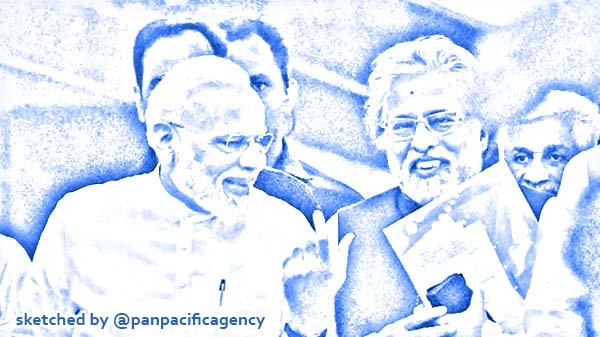One nation, one election: An RSS-BJP agenda lingering for two decades in India

Prime Minister Narendra Modi with TMC leader Sudip Bandyopadhya on Sunday in New Delhi. (Photo: PTI). Sketched by the Pan Pacific Agency.
NEW DELHI, Jun 19, 2019, India Today. India’s political spectrum is split over the issue of “one nation one election” push by Prime Minister Narendra Modi, who has called a meeting of all party presidents on the matter today. Bahujan Samaj Party chief Mayawati, Trinamool Congress president Mamata Banerjee and Telugu Desam Party boss N Chandrababu Naidu have voiced their opposition and would not be part of the meeting called by PM Modi, reported the India Today.
Simultaneous elections to the Lok Sabha and the state assemblies would reduce election expenditure, lessen political animosity and free governance from the political compulsions of model code of conduct and poll promises.
When one nation one election was the norm
Concurrent elections were the norm between 1951 and 1967. During this period elections to the Lok Sabha were held fully or partially with state polls.
While all states went to the polls for the Lok Sabha and local assemblies in 1951-52, the reorganisation of states and dismissal of governments saw percentage of states voting simultaneously for both came down to 76 per cent in 1957 and 67 per cent in 1962 and 1967. The link broke almost completely in 1970s.
The RSS-BJP combine revived the debate in the late 1990s, when the BJP was gaining prominence in elections and Atal Bihari Vajpayee formed three – including one of 13 days – governments. BJP veteran LK Advani was a vocal proponent of simultaneous elections.
Debate revives under Vajpayee
In 1999, a law commission report during Vajpayee rule recommended holding elections to the Lok Sabha and state assemblies. The law commission had proposed that when a no-confidence motion is moved against a government, it should also have a resolution for vote confidence for an alternative government.
In a meeting over “one nation one election” proposal, the law commission held an all-party meeting last year. Interestingly, the BJP along with the Congress had not stated any categorical view on the question.
The All India Anna Dravida Munnetra Kazhagam, the Samajwadi Party and YSR Congress came out in support of the proposal while the Communist Party of India, the BSP, the TMC, the TDP and a few others had opposed holding simultaneous elections.
The Modi push
In Januaray 2017, PM Modi suggested at a function that a feasibility study for holding simultaneous elections should be done. Three months later speaking at a meeting of the Niti Aayog with the chief ministers, PM Modi reiterated that possibility of holding simultaneous Lok Sabha and state elections should be explored.
Curiously, Modi’s push followed a parliamentary committee report in December 2015 — under the chairmanship of the then Rajya Sabha MP EM Sudarsana Natchiappan of the Congress — recommended simultaneous elections to the Lok Sabha and the state assemblies.
After Modi’s push, the Niti Aayog, in a Note on Simultaneous Elections suggested a formula to hold concurrent Lok Sabha and assembly polls in two phases by 2021 but that proposal also included 2019 general elections in its ambit.
The recent polls, however, were not held according to that proposal. OP Rawat as chief election commissioner in October 2017 had said that the poll panel was equipped to hold simultaneous elections but the decision had to be taken at the political level.
After the BJP’s victory in the Lok Sabha election, PM Modi has given the idea a fresh push but to stiffer resistance from the Opposition.